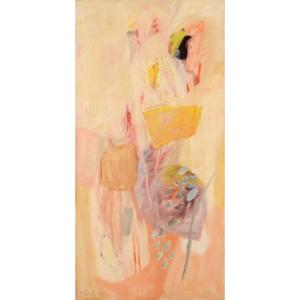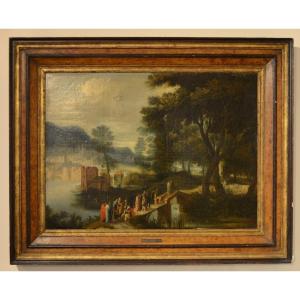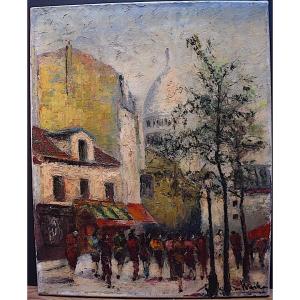The painting depicts a coastal scene, likely set in Marseille, as indicated by the title. The view includes a prominent old chapel or castle, with its structure blending seamlessly into the surrounding town. The foreground features the rocky shoreline and the shimmering water, painted with meticulous attention to the play of light on the surface. The midground is dominated by the architectural elements of the town, with buildings arranged linearly, leading the viewer’s eye towards the central structure. The background fades into a soft, atmospheric haze, emphasizing the distance and adding depth to the scene.
Aurrens employs a soft, pastel colour palette, with predominant hues of blues, pinks, purples, and ochres. This choice of colors creates a harmonious and tranquil mood, typical of the post-impressionist style. The interplay of light and shadow is subtle yet effective, with light reflections on the water capturing the time of day, possibly early morning or late afternoon. The buildings are bathed in a gentle, diffused light, enhancing the sense of calm and quiet in the scene. Aurrens uses the pointillism technique, characterized by small, distinct dots of colour applied in patterns to form the image. This method brings a vibrancy to the painting and allows the colors to visually blend when viewed from a distance, creating a luminous effect.This method brings a vibrancy to the painting and allows the colours to visually blend when viewed from a distance, creating a luminous effect.
The brushwork is delicate and controlled, with each dot carefully placed to build up the forms and textures within the scene. This approach creates a textured surface that captures the light in different ways, depending on the viewer’s perspective. The overall mood of the painting is tranquil and serene. The soft colour palette and the gentle blending of colors evoke a sense of calm, making the viewer feel at peace with the coastal setting. The depiction of the old chapel and the surrounding town conveys a sense of timelessness, as if capturing a moment that has remained unchanged for centuries. The painting also reflects Aurrens' connection to Marseille and the Provence region, capturing the unique light and atmosphere of the Mediterranean coast.
Henri Aurrens (1873-1934)
Henri Aurrens, born Louis Henri Joseph Aurrens on October 27, 1873, in Marseille, France, was a prominent French painter, illustrator, and caricaturist. He spent his formative years in Marseille, where he developed an early interest in the arts. In his early career, Aurrens moved to Paris, the epicentre of the art world, to further his artistic pursuits. There, he illustrated postcards and created caricatures for various magazines, earning a living while honing his skills. He eventually returned to his hometown of Marseille, where he adopted the Pointillism style, a technique characterized by small, distinct dots of colour to form an image.
Henri Aurrens is best known for his landscape paintings, which often feature the vibrant and atmospheric scenes of Provence. His work "À Montredon" is housed in the Musée Gassendi in Digne-les-Bains, and "Matin de printemps" can be found in the Musée Cantini in Marseille. These works reflect his ability to capture the light and colour of the southern French landscape. Aurrens' work was well-received during his lifetime, and he participated in numerous exhibitions. His contributions to art were recognized in various public collections and exhibitions, making him a respected figure in the post-impressionist movement. Despite his success, much of his work remains lesser-known today, with some pieces housed in public collections and others in private hands. Henri Aurrens lived a life dedicated to art until his death on May 6, 1934, in Marseille. His legacy continues through his paintings, which capture the essence of the French landscape and the evolution of post-impressionist techniques.


















































 Le Magazine de PROANTIC
Le Magazine de PROANTIC TRÉSORS Magazine
TRÉSORS Magazine Rivista Artiquariato
Rivista Artiquariato